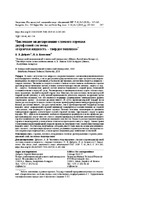| dc.contributor.author | Добрего, К. В. | |
| dc.contributor.author | Козначеев, И. А. | |
| dc.coverage.spatial | Минск | ru |
| dc.date.accessioned | 2019-05-31T11:19:02Z | |
| dc.date.available | 2019-05-31T11:19:02Z | |
| dc.date.issued | 2019 | |
| dc.identifier.citation | Добрего, К. В. Численное моделирование слоевого горения двухфазной системы «горючая жидкость – твердое топливо» = Numerical Simulation of Two-Phase System of “Combustible Liquid – Solid Fuel” Combustion in a Fixed Bed / К. В. Добрего, И. А. Козначеев // Энергетика. Известия высших учебных заведений и энергетических объединений СНГ. – 2019. – № 3. – С. 247-263. | ru |
| dc.identifier.uri | https://rep.bntu.by/handle/data/53116 | |
| dc.description.abstract | В связи c актуальностью вопросов совершенствования сжигания многокомпонентного и нестандартного топлива, а также для решения ряда экологических задач требуются исследования горения сложных гетерогенных, в частности двухфазных, систем типа «горючая жидкость – твердое топливо». Численно исследуются количественные и качественные особенности горения двух модельных топливных систем, условно соответствующих смесям «опилки – нефть» и «щепа – нефть». Особенностью данных систем является подвижность жидкой фазы, увлекаемой газовым потоком в пористой среде. Рассматривается одномерная плоская задача слоевого горения с поджигом с нижней и верхней сторон слоя. Показано, что для системы с мелкодисперсной твердой фазой (опилки), в силу низкой проницаемости для газов, скорость воздушного дутья относительно невысока, что обусловливает медленное формирование температурного фронта (характерное время – несколько десятков минут). В случае крупнодисперсной твердой фазы (щепа) расход воздуха больше и соответствующее время формирования температурных фронтов меньше (несколько минут). Как для случая мелко-, так и крупнодисперсной твердой фазы при поджиге снизу жидкофазный горючий компонент эвакуируется газовым потоком из горячей зоны раньше, чем формируется фронт горения. Поэтому основные закономерности динамики температурного фронта соответствуют «сухой» горючей системе. При поджиге сверху за время порядка 100 с (при использованных значениях параметров) формируется волна прогрева, распространяющаяся сверху вниз по слою и сопровождающаяся частичным окислением твердого горючего компонента при полном расходовании окислителя. Скорость распространения фронта горения в моделируемых условиях мало отличается при поджиге снизу и сверху. Однако время установления квазистационарной скорости фронта на начальном этапе значительно меньше при поджиге снизу. Результаты, полученные авторами, могут быть использованы для оптимизации слоевого сжигания многофазных топлив, режимных параметров метода внутрипластового горения при нефтедобыче, а также при исследовании ряда химических технологий. | ru |
| dc.language.iso | ru | ru |
| dc.publisher | БНТУ | ru |
| dc.title | Численное моделирование слоевого горения двухфазной системы «горючая жидкость – твердое топливо» | ru |
| dc.title.alternative | Numerical Simulation of Two-Phase System of “Combustible Liquid – Solid Fuel” Combustion in a Fixed Bed | ru |
| dc.type | Article | ru |
| dc.identifier.doi | 10.21122/1029-7448-2019-62-3-247-263 | |
| local.description.annotation | Investigation of combustion of complex heterogeneous systems and particularly of two-phase “combustible liquid – solid fuel” systems is topical because of the need to improve combustion of multicomponent and non-standard fuels as well as for resolution of specific ecological problems. The qualitative and quantitative peculiarities of combustion of two model combustible systems, notionally corresponding to the “sawdust – oil” and “wood chips – oil” mixtures are investigated numerically. The main peculiarity of the systems is volatility of the fluid component, being gaseous-flow driven inside porous media. A one-dimensional plain problem of combustion of compact layer with the ignition from the bottom and from the upper side is considered. It is demonstrated that due to low gas permeability of the fine-dispersed solid matrix (sawdust), air flow velocity is relatively low which results in slow formation of the combustion front (the characteristic time is tens of minutes). In case of coarse solid phase (wood chips), airflow rate is higher and corresponding time of temperature fronts formation is smaller (a few minutes). Both for the cases of fine-dispersed and coarse particles solid matrix phase, when set on fire from below, the fluid component is evacuated from the hot zone before the combustion front is formed. Since that, the main characteristics of the temperature front dynamics correspond to “dry” fuel system. In case of upper side ignition the combustion wave is formed at the time of the order of 100 s (when the used magnitudes of parameters are being used again), then it spreads downstream of the layer, accompanied by incomplete oxidation of solid fuel and complete combustion of oxygen. The effect of incomplete solid fuel combustion was noted earlier in the investigations of combustion of lean coal layer and some other systems. The velocity of the combustion wave propagation does not differ much for the cases of upper side and bottom side ignition. But the time of establishing the quasi-stationary velocity of the front to the steady-state value at the initial stage is much less in case of bottom side ignition. The results obtained by the authors can be utilized for optimization of multi-phase fuels combustion in compact layer, the regime parameters of in-situ combustion method of oil recovery increase as well as for improvement of some specific chemical processes. | ru |

